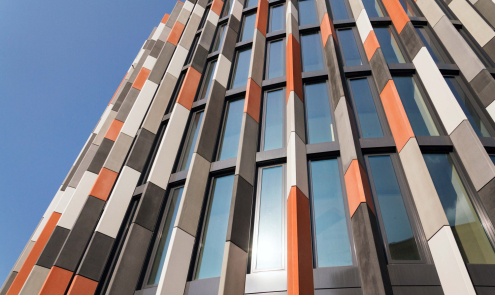WHAT IS BREEAM?
17 Feb 2021
BREEAM (Building Research Establishment Environmental Assessment Method) is the world’s largest method of assessment, rating and certifying the sustainability of masterplanning projects, infrastructure and buildings. Undertaken by a qualified BREEAM assessor, its main purpose is to raise awareness among owners, occupiers, designers and operators as to the benefits of taking a sustainable approach. BREEAM recognises and reflects the value in higher performing assets across the built environment lifecycle, from new construction to in-use and refurbishment.
BREEAM: a closer look
Adhering to standards developed by BRE (Building Research Establishment), BREEAM assessors perform third party certification to assess an asset’s environmental, social and economic sustainability performance. This measurement and fulfilment of the assessment criteria means BREEAM-rated developments can be referred to as more sustainable environments which; enhance the wellbeing of those who live and work in them; protect natural resources and make for more attractive property investments.
BREEAM is a useful mechanism for planning authorities to measure the sustainable credentials of new or refurbished commercial buildings in their boroughs. BREEAM assessments often form part of the planning conditions to be discharged at completion of the project. The benefits that a BREEAM assessment offers to clients include the creation of sustainable principles as part of the design from the outset, which often leads to energy and carbon savings at occupation stage.
BREEAM is formally assessed at two stages. This is achieved through the collation of evidence by the BREEAM assessor and submission to the BRE for auditing and certification. The two stages are:
1. Design stage certificate: The majority of the evidence is based on letters of confirmation, drawings, specifications and commitments.
2. Post construction certificate: As well as collecting certificates of completion, this stage involves a site visit to check the designs have been adhered to and completed accordingly. A document comprising the necessary photo evidence is consequently produced.
Whitecode’s BREAAM assessment
At Whitecode, we make sure we are part of the design team from an early stage so we are able to advise on BREEAM credits. All of our BREEAM assessors are qualified BREEAM Accredited Professionals (AP), which not only allows us to take an active role in the assessment, we can guide the team to ensure the required BREEAM target is met.
The BREEAM New Construction 2018 standard stipulates that many of the credits must be addressed and evidence submitted before the submission of the planning application. It is much harder to achieve a BREEAM rating of Excellent without early engagement with BREEAM and the assessor, as many of the credits are lost. The team of BREEAM assessors at Whitecode are experienced in providing advice and pre-assessment for planning submissions and GLA applications. We can also complete the Life Cycle Assessment of materials alongside this, which can provide up to 10% of the vital credits at this stage.
The pre-assessment provided at planning stage should provide a good representation of the credits required to meet the target BREEAM rating. At Whitecode, we have the knowledge of credits to recommend a strategy which makes the most of the scheme, approaching the target BREEAM rating with realistic solutions that work for the design team. We do not agree with committing to credits which are unachievable or do not provide good value for money.
Whitecode’s BREEAM assessment process
Whitecode has the knowledge and experience to conceive BREEAM assessments, but are also highly adept at reviewing existing pre-assessments which have already been submitted during the planning process. Working with the team, we evaluate the credits that have been suggested and complete due diligence. There are some credits which are mandatory to meet certain BREEAM targets but many are tradable. We are able to explain the implications of these, as well as offer support to complete further reports that complement the overall assessment.
Following the completion or review of the pre-assessment, one of our BREEAM assessors will populate our bespoke BREEAM tracker. This is the tool we use to communicate the requirements to the design team, and track the predicted and actual achieved score. As the physical BREEAM manual contains over 390 pages, we take it upon ourselves to speak the language of our clients and ensure the whole design team understands their specific requirements.
We pride ourselves on making BREEAM as straightforward as possible. We have many templates from previous jobs to assist with creating BRE-approved evidence, and will support each of the design disciplines whether it is their first or hundredth BREEAM assessment process.
Throughout the design stage we will attend DTM and technical workshops to ensure the BREEAM standards are met, giving support where needed. As and when evidence is submitted, we review it to ensure it is compliant. The BREEAM score increases until we have met the required target.
Whitecode would always recommend aiming for at least a few percent over the desired BREEAM target. This accounts for any issues during construction that may affect compliance. It is also important to bear in mind the timescale required for the BRE to audit and respond to the BREEAM submission, and if any further evidence is requested. Clients must be mindful of this when there is a planning condition to discharge; e.g., within three months of occupation.
Which buildings can be BREEAM assessed?
BREEAM assessments can be undertaken across all manner of buildings including commercial, education, healthcare and industrial. All assessments follow roughly the same procedure, but there are some credits which are only relevant to certain building types or their location:
• BREEAM: Offices
i. The desk layout is important as it will reduce solar glare from windows. This will ensure they are grouped to have control of the lighting, and save energy by not lighting the entire office on one switch.
ii. There needs to be information as to whether the floor finish is specified by the end user. Here, we want to avoid flooring being installed for sales purposes and replaced straight away.
• BREEAM: Industrial
i. Some industrial spaces are unconditioned. In order to complete a BREEAM assessment we need an energy assessment too, as at least part of the building must have heating/hot water services.
• BREEAM: Retail
i. Cycle storage can be provided for small groups of retail units as a communal facility.
• BREEAM: Education
i. University buildings could contain laboratories which have tailored requirements in the assessment.
• BREEAM: Healthcare
i. If it is an NHS project there may be some specific requirements in terms of contractors’ credentials (ISO14001), which must be adhered to.
• BREEAM: Prison
i. Some requirements for daylighting etc. are different in these buildings.
• BREEAM: Law Courts
i. Requirements for acoustics are very important.
• BREEAM: Multi-Residential
i. Co-living is becoming increasingly popular especially in London. These fall under this section.
• BREEAM: Care Homes
i. Specific requirements for design and use of mobility buggies rather than cycles.
• BREEAM: Hotel
i. Many hotels also include restaurants. Depending on how they are run, this facility may require a separate BREEAM assessment.
• BREEAM: Library/ art gallery
i. These often form part of a civic centre assessment. A bespoke method, if appropriate, can also be used.
• BREEAM: Cinema/ theatre
i. May have unpredictable occupancies, which must be taken into account during the design of the ventilation system.
• BREEAM: Domestic refurb projects
i. Refurbishment of an existing residential building, or perhaps a conversion of an old industrial building, to create the right living space.
To complement any of the BREEAM assessment, Whitecode offers additional assessments such as building user guides, air quality plans, lifecycle costing plans, thermal comfort, SBEM, daylighting reports, passive design analyses and qualified BREEAM AP services. BREEAM APs take a more active role in the assessment, helping the design team set targets during RIBA Stages 1-4 and then ensuring they stay on track to achieve their targets throughout construction and handover. The use of a BREEAM AP can contribute at least three valuable credits to the assessment. Whitecode provides simple-to-use evidence templates to ease the collating of robust, auditable and reliable BREEAM compliant information.
Case studies
1. Big Yellow Self Storage
Whitecode undertook the BREAAM assessments for the new Big Yellow Self Storage site in Camberwell, south London. The commercial development incorporates around 8,500sqm of self-storage space (including mezzanine floors) and 2,000sqm of flexi-offices, designed to accommodate small businesses and start-ups.
Whitecode was selected for this project due to its high-levelled sustainability expertise, not to mention its longstanding relationship with a member of the client’s team. Whitecode collaborated with client, Big Yellow Construction and main contractor, Glencar Construction on this project.
There are around 10 different assessment sections pertaining to various degrees of sustainability. For this particular project, it was essential for the Big Yellow Self Storage site to achieve BREEAM Excellent to fulfil its planning obligations. Furthermore, on this project one of the main sustainability considerations was that the site would comprise largely unoccupied spaces. Although these spaces wouldn’t be continually inhabited by people, there was a need for the building to perform efficiently and sustainably nonetheless.
As with all its projects, Whitecode worked with the client to shape a strategy as to how Big Yellow Self Storage could achieve BREEAM Excellent. Whitecode led this process, collaborating with client teams to highlight how the site could be as sustainable as possible. As the BREEAM assessor, Whitecode divided the project into two stages; performing a design stage assessment where its sustainability team assessed all the plans and specifications in order to achieve a design stage certificate prior to construction. Whitecode then completed a post-construction certificate which will ascertain whether the project meets its projected sustainability credentials.
With Whitecode’s vital assistance, the Big Yellow Self Storage project has received BREEAM Excellent for the design stage assessment. This assessment highlighted that due to the presence of PV panels, the project received 10 credits for energy performance (five is needed to meet Excellent). As well as receiving an Excellent classification for energy performance, the project’s lighting proposals were met with praise. All heating and lighting will be sensor-controlled through a BMS system, so when a space is uninhabited for instance, the lights will switch themselves off to keep energy usage low. Showers, taps and toilets will all have water restrictions to reduce usage in building.
As well as ensuring the site’s interiors will be of comfort to the eventual occupants, Big Yellow Self Storage, Camberwell will encourage its inhabitants to lead a healthy, environmentally-conscious lifestyle. Dedicated recycling bins enable people to recycle within the workspaces and bicycle storage inspires workers to cycle to work.
Completed in summer 2020, Whitecode played an essential role in assuring this sustainable commercial site will perform excellently into the future.
2. Scape projects: Canada Water – The Mulberry Site and Pause
Whitecode is currently completing the BREEAM assessments for King’s College London’s newest student accommodation, Canada Water – The Mulberry Site. The world-class university is developing the former Mulberry Business Park site at Canada Water to create 770 new student rooms, office space, affordable housing, retail units, a health care centre and landscaped public space.
Whitecode is collaborating with main contractor, HG Construction and client and end-user Scape, a luxury student accommodation brand. Scape is invested in building sustainably, where students’ comfort and living are at the forefront of the company’s ethos. This focus on creating beautiful, enjoyable interiors led Scape to engage Whitecode in performing the BREEAM assessments, where it is hoped the site will achieve an Excellent rating. Now at RIBA Stage 4, Whitecode will perform an occupancy evaluation post-construction so further credits can be achieved.
Pause, Hackney
Whitecode has been engaged to undertake the BREEAM assessment for the first co-living scheme of its kind in Haggerston, a seven-storey site overlooking the Kingsland Basin.
Scape is developing this unique project in the London Borough of Hackney, a 121-bedroom scheme on Kingsland Road. Named Pause, the development comes under Scape’s residential arm, Bode Properties. Plans designed by pH+ architects propose a development of up to seven storeys, with each floor containing around 26 co-living rooms in clusters of three to eight units with two shared kitchens. The bijoux rooms will be available in either 19 sqm or 24 sqm.
On every project, Whitecode assesses against the same criteria, pursuing certain adaptations depending on the kind of unit at hand. For this development in particular, BREEAM Excellent is a prerequisite of Hackney Council’s planning application, where any building over a certain level must achieve this classification. Additionally, with co-living a relatively novel concept, new considerations had to be paid to making the best use of small spaces including room for waste. To achieve the waste credits, measures have to be put in place to ensure the small kitchens contain disposal units which separate compost and recycling, for example. Another assessment criterion for co-living and student accommodation is access to open space and gardens, with break out areas, access to transport cycle storage and local bus routes vital for students.
Whitecode will be utilising its knowledge and expertise to devise BREEAM strategies for its client, Scape, to create energy-efficient, sustainable interior and exterior spaces that assure the comfort of the two sites’ eventual occupants for years to come.

The fight for facades: Why M&E must shape...
With sustainability and energy efficiency, not to mention decarbonisation, increasingly taking priority during building design, MEP engineers and architects are coming into conflict as part of an ever-changing air quality...
Read MoreLike to Know More? Let's Talk...








